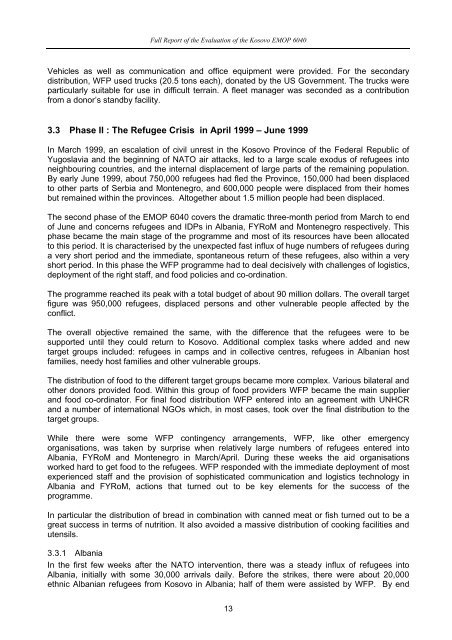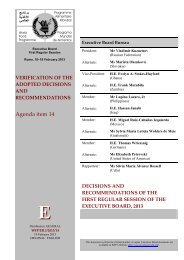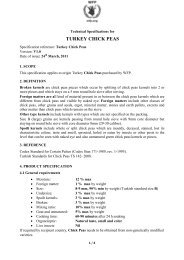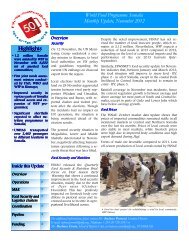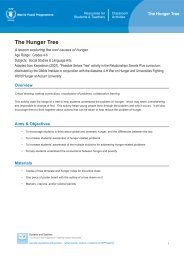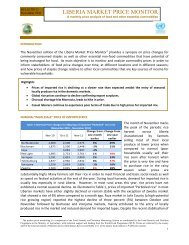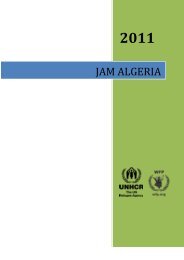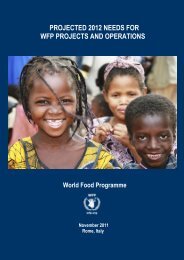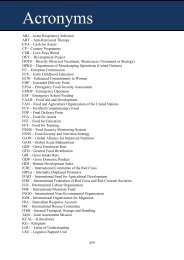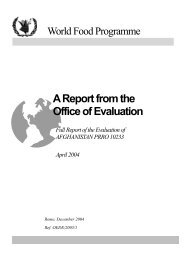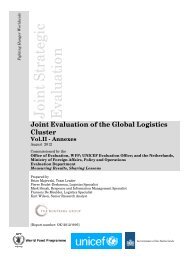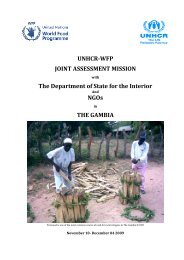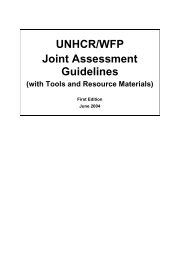Full Report - WFP Remote Access Secure Services
Full Report - WFP Remote Access Secure Services
Full Report - WFP Remote Access Secure Services
You also want an ePaper? Increase the reach of your titles
YUMPU automatically turns print PDFs into web optimized ePapers that Google loves.
<strong>Full</strong> <strong>Report</strong> of the Evaluation of the Kosovo EMOP 6040<br />
Vehicles as well as communication and office equipment were provided. For the secondary<br />
distribution, <strong>WFP</strong> used trucks (20.5 tons each), donated by the US Government. The trucks were<br />
particularly suitable for use in difficult terrain. A fleet manager was seconded as a contribution<br />
from a donor’s standby facility.<br />
3.3 Phase II : The Refugee Crisis in April 1999 – June 1999<br />
In March 1999, an escalation of civil unrest in the Kosovo Province of the Federal Republic of<br />
Yugoslavia and the beginning of NATO air attacks, led to a large scale exodus of refugees into<br />
neighbouring countries, and the internal displacement of large parts of the remaining population.<br />
By early June 1999, about 750,000 refugees had fled the Province, 150,000 had been displaced<br />
to other parts of Serbia and Montenegro, and 600,000 people were displaced from their homes<br />
but remained within the provinces. Altogether about 1.5 million people had been displaced.<br />
The second phase of the EMOP 6040 covers the dramatic three-month period from March to end<br />
of June and concerns refugees and IDPs in Albania, FYRoM and Montenegro respectively. This<br />
phase became the main stage of the programme and most of its resources have been allocated<br />
to this period. It is characterised by the unexpected fast influx of huge numbers of refugees during<br />
a very short period and the immediate, spontaneous return of these refugees, also within a very<br />
short period. In this phase the <strong>WFP</strong> programme had to deal decisively with challenges of logistics,<br />
deployment of the right staff, and food policies and co-ordination.<br />
The programme reached its peak with a total budget of about 90 million dollars. The overall target<br />
figure was 950,000 refugees, displaced persons and other vulnerable people affected by the<br />
conflict.<br />
The overall objective remained the same, with the difference that the refugees were to be<br />
supported until they could return to Kosovo. Additional complex tasks where added and new<br />
target groups included: refugees in camps and in collective centres, refugees in Albanian host<br />
families, needy host families and other vulnerable groups.<br />
The distribution of food to the different target groups became more complex. Various bilateral and<br />
other donors provided food. Within this group of food providers <strong>WFP</strong> became the main supplier<br />
and food co-ordinator. For final food distribution <strong>WFP</strong> entered into an agreement with UNHCR<br />
and a number of international NGOs which, in most cases, took over the final distribution to the<br />
target groups.<br />
While there were some <strong>WFP</strong> contingency arrangements, <strong>WFP</strong>, like other emergency<br />
organisations, was taken by surprise when relatively large numbers of refugees entered into<br />
Albania, FYRoM and Montenegro in March/April. During these weeks the aid organisations<br />
worked hard to get food to the refugees. <strong>WFP</strong> responded with the immediate deployment of most<br />
experienced staff and the provision of sophisticated communication and logistics technology in<br />
Albania and FYRoM, actions that turned out to be key elements for the success of the<br />
programme.<br />
In particular the distribution of bread in combination with canned meat or fish turned out to be a<br />
great success in terms of nutrition. It also avoided a massive distribution of cooking facilities and<br />
utensils.<br />
3.3.1 Albania<br />
In the first few weeks after the NATO intervention, there was a steady influx of refugees into<br />
Albania, initially with some 30,000 arrivals daily. Before the strikes, there were about 20,000<br />
ethnic Albanian refugees from Kosovo in Albania; half of them were assisted by <strong>WFP</strong>. By end<br />
13


